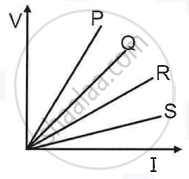Advertisements
Advertisements
प्रश्न
Give a scientific reason.
Tungsten metal is used to make a solenoid type coil in an electric bulb.
उत्तर
- The electric bulb works on the principle of the heating effect of electric current.
- The solenoid-type coil of the bulb has high resistivity and a very high melting point.
- When current is passed through the bulb, the solenoid-type coil of the bulb gets heated to a high temperature (up to 3400°C) and starts glowing.
Hence, tungsten metal makes a solenoid-type coil in an electric bulb.
APPEARS IN
संबंधित प्रश्न
State four most common electrical appliances based on heating effect of electric current. Why do we use finely heated platinum wire in surgery?
An electric iron of resistance 20 Ω takes a current of 5 A. Calculate the heat developed in 30 s.
Why is the tungsten used almost exclusively for filament of electric lamps?
An electric heater is connected to the 230 V mains supply. A current of 8 A flows through the heater.
(a) How much charge flows around the circuit each second?
An electric heater is connected to the 230 V mains supply. A current of 8 A flows through the heater.
(b) How much energy is transferred to the heater each second?
An electric kettle rated at 220 V, 2.2 kW, works for 3 hours. Find the energy consumed and the current drawn.
Explain why, tungsten is used for making the filaments of electric bulbs.
Explain why, the current that makes the heater element very hot, only slightly warms the connecting wires leading to the heater.
A heating coil has a resistance of 200 Ω. At what rate will heat be produced in it when a current of 2.5 A flows through it?
Derive the expression for the heat produced due to a current 'I' flowing for a time interval 't' through a resistor 'R' having a potential difference 'V' across its ends. With which name is this relation known?
How much heat will an instrument of 12 W produce in one minute if it is connected to the heat produced by it?
The elements of electrical heating devices are usually made of:
(a) tungsten
(b) bronze
(c) nichrome
(d) argon
If the current flowing through a fixed resistor is halved, the heat produced in it will become:
Why does tungsten metal used to make solenoid type coil in an electric bulb?
Answer the following question:
what is the heating effect of the electric current? state any four applications of it?
The ‘live’ and the ‘neutral’ wires have potential difference of _______.
What is overloading?
When does overloading occur?
True or False – If False give the correct answer
The fuse wire does not melts whenever there is overload in the wiring.
Heating effect of current is called ______
Name any two appliances which work under the principle of heating effect of current.
An electric iron consumes energy at the rate of 420 W when heating is at the maximum rate and 180 W when heating is at the minimum rate. The applied voltage is 220 V. What is the current in each case?
An electric iron draws a current of 4 A when connected to 220 V mains. Its resistance must be:
Which of the following gases are filled in electric bulbs?
How does use of a fuse wire protect electrical appliances?
What is Joule’s heating effect? How can it be demonstrated experimentally? List its four applications in daily life.
An electric fuse has a body made of ceramic and two points for connecting the fuse wire.
What are the uses of electromagnets?
It would cost a man Rs. 3.50 to buy 1.0 kW h of electrical energy from the Main Electricity Board. His generator has a maximum power of 2.0 kW. The generator produces energy at this maximum power for 3 hours. Calculate how much it would cost to buy the same amount of energy from the Main Electricity Board.
Match the following
| 1. | Bulb | a. | Conductor |
| 2. | Electroplating | b. |
Insulator |
| 3. | Pure water | c. | Heating effect of current |
| 4. | Salt solution | d. | Chemical effect of current |
Assertion: A current-carrying wire should be charged.
Reason: The current in a wire is due to the flow of free electrons in a definite direction.
Name a few appliances which work on the basis of the heating effect of current.
A student boils water in an electric kettle for 20 minutes. Using the same mains supply he wants to reduce the boiling time of water. To do so should he increase or decrease the length of the heating element? Justify your answer.
The electric fuse works on the Joule heating principle.
In the electric equipment producing heat like iron, electric heater, boiler, toaster etc., an alloy such as nichrome is used, not pure metals.
Write an expression for the amount of heat produced in a resistor when an electric current is passed through it stating the meanings of the symbols used.
State the law that explains the heating effect of current with respect to the measurable properties in an electrical circuit.
The graph of voltage vs current for four different materials is shown below.

Which of these four materials would be used for making filament of bulb?
